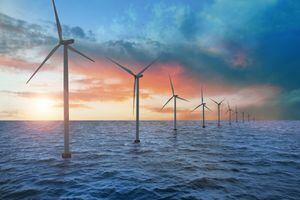We could be the Terawatt Islands
The potential for generating renewable energy in Guernsey is enormous, says Andy Sloan – so what are we waiting for?

Sorry to disappoint online poster Cher Eugene but I’m on a bit of a roll. First fan mail and now requests.
My old friend Dom Wheatley asked me if I’d be finding time to visit the issues raised in Guernsey Electricity’s recent tariff consultation. As luck would have it, I had been planning to discuss our net zero commitments and sustainable energy generation (and our funding thereof) sometime. It’s part of the International Sustainability Institute Channel Islands’ agenda. We’re working on a paper on the economics and financing of renewable generation across the Channel Islands for publication later this year. So why not now?
My opinion on the subject is simple. I’ve said it many, many times. I’ve said it in speeches, I’ve said it in these pages. I’ve probably said it in my sleep. There is a clear opportunity for Guernsey and Jersey to together become the Terawatt Islands. That is, our potential renewable energy generating capacity is pretty enormous.
As we wrote in our environmental research briefing last year: ‘The potential is significant. The Royal Society suggests the potential for anywhere between 2 to 12GW of tidal capacity across the Channel Islands together with scope for upwards of 8GW of offshore wind capacity. At the upper bound, 20GW of capacity would equate to a fifth of current UK generating capacity. Such scale would require billions in capital, complicated commercial agreements and most likely development of major public private partnerships.’
Developing a roadmap on this is what we’re working on at the Institute, looking to work with various private sector partners in the process.
During the chamber panel on tax at the OGH on Monday lunchtime, the question about diversifying and growing our economy made its perennial appearance. Time precluded my contribution on the point there and then, but what I’d wanted to say was that generating and exporting terawatts of renewable energy would be a pretty sound contribution to growing and diversifying our economy.
I’m sure the editor would be able to dig out one of the old Guernsey Press front pages after an uncharacteristically positive IOD convention on renewable energy from 10 or 12 years ago. 2009, 2010 was it? We were all rather excited about the potential back then. Sadly, though, it’s another one of those areas where Guernsey’s managed pretty much the square root of zero in terms of progress in 15 years. Tax being another.
Turns out I’m not alone in that view – it was pretty much the theme of Monday’s conversation at the OGH.
I’ve told this anecdote many times but back in the day, Jon Buckland, then chief officer of Commerce and Employment, as it then was, asked me if I could look at the economics of offshore wind. Luckily, I had a mate that worked in financing infrastructure investment and, one quick phone call later, I was able to whip up the model on a spreadsheet. No surprise but back then the numbers didn’t work. If memory serves, costs were greater than revenues by around a factor of three. Today, it’s common knowledge that offshore wind is second only to onshore wind as the cheapest form of electricity generation in western Europe. So you’d think by now…
But if we’re going to meet those net zero targets we’ve cheerfully signed up for, we had better start making some progress soon.
Now, it’s one thing signing up to these net zero target thingies but we do need to understand that just wishing doesn’t make it so. And it’s going to cost. Though again, as we agreed at the OGH, the absence of any reliable or even reasonable estimates of these costs for Guernsey is concerning strategically. But no matter, like I said, we’re working on it at the Institute.
Just to digress for one point. Achieving net zero is non-negotiable for us. We live in a part of the world (AKA Europe) where a commitment to doing this is expected. It’s something we have to do. So quickly figuring out how to do it and how to fund it is rather important. And just for a reality check, other than laying the interconnector and getting a windfall drop in our attributed greenhouse gas emissions we have done nothing material to reduce emissions in 30 years. That is, once you remove the ‘windfall’ drop from the interconnector our GHG emissions are no different to what they were in 1992. Which doesn’t augur well for progress and meeting our interim 2030 targets, unless there’s a secret plan. After all, 2030’s just over seven years away.
So it was with a tremor of excitement that I followed the advice of my old friend and responded to GE’s tariff consultation. I was a bit disappointed. It was a trifle loaded if you ask me and clearly had just one objective in mind. Support the interconnector! Frankly, the way it was written, you’d have to have been pretty bloody minded not to have responded in favour of GE’s preferred option of laying another cable to France. It seemed to have so many positive attributes I wouldn’t have been surprised if they’d said it also makes the bed and mows the lawn.
I’m not against the cable link per se, but what concerns me was the inherent short termism implied by the thinking on display that accompanied the sales pitch. And the path that Guernsey Electricity seems intent on committing us to long term. Namely, importing over domestic generation and export.
Personally, I’d prefer not to be committed to paying the French tens of millions of pounds per annum thank you, particularly if we can find a way to generate our needs at near zero marginal cost in the future. And that’s setting aside the fact that it’s pretty much a year to the day that they threatened to cut off Jersey’s electricity supply (and thus ours). There are genuine security of supply issues to consider.
Accompanying all this is an interesting microsite on GE’s webpage. ‘Our electric future’. It rather boldly states that ‘Local renewables alone cannot provide the electricity we need today, let alone in the future.’ I assume it’s reliant on the premise that it’s too costly to store electricity at scale. But this seems very Malthusian to me and I rather disagree.
I’ve been an expert reviewer for the IPPC’s Working Group III’s sixth assessment for the last two years. That’s the report on climate change mitigation that was published just three weeks ago, so I’m reasonable up to speed on current trends. I’m pretty sure that forecasts suggest improving battery technology results in the renewable plus storage model becoming economically viable in the next 10 years or so. That’s plenty within the timescales we’re supposedly planning for, ie. 2050.
When I originally planned this piece, it was going to be a discussion of our sustainable energy generation at scale, its funding etc. I hadn’t expected having to take five to address what I consider to be quite dangerous comments from our local utility.
Like I said, I’ve no objections to the interconnector in principle. I do however object to public statements that have the potential to falsely condition public opinion and send thinking down a path where we fail to exploit the opportunity for sustainable energy generation and fail to achieve our potential of becoming one of the Terawatt Islands. It’s going to cost billions and be one hell of a challenge. But it’s too great an opportunity not to try.
Cher Eugene, did you follow me this month?





